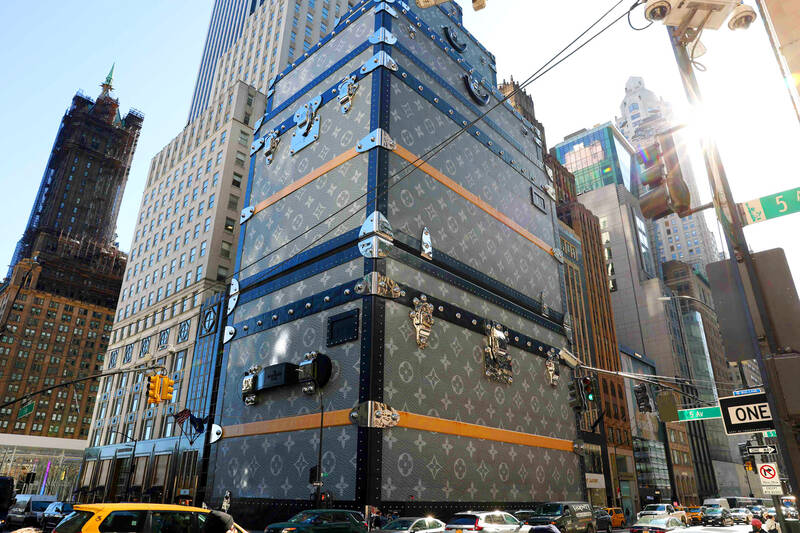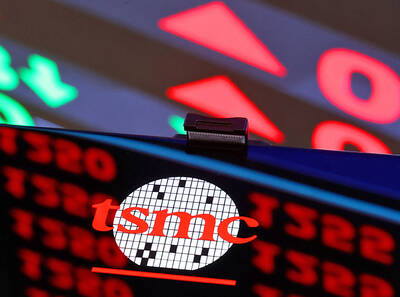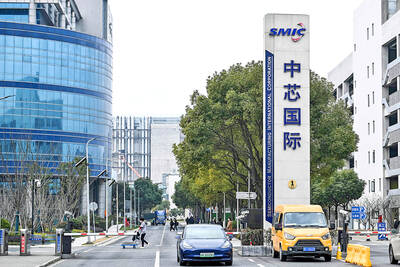Six years ago, LVMH’s billionaire CEO Bernard Arnault and US President Donald Trump cut the blue ribbon on a factory in rural Texas that would make designer handbags for Louis Vuitton, one of the world’s best-known luxury brands.
However, since the high-profile opening, the factory has faced a host of problems limiting production, 11 former Louis Vuitton employees said.
The site has consistently ranked among the worst-performing for Louis Vuitton globally, “significantly” underperforming other facilities, said three former Louis Vuitton workers and a senior industry source, who cited internal rankings shared with staff.

Photo: AFP
The plant’s problems — which have not previously been reported — highlight the challenges for LVMH as it attempts to build its production footprint in the US to avoid Trump’s threatened tariffs on European-made goods.
“The ramp-up was harder than we thought it would be, that’s true,” Louis Vuitton industrial director Ludovic Pauchard said in an interview on Friday.
The Texas site, situated on a 101-hectare ranch, has struggled due to a lack of skilled leather workers able to produce at the brand’s quality standards, the three former workers said.
“It took them years to start making the simple pockets of the Neverfull handbag,” one source familiar with operations at the plant said, referring to the classic Louis Vuitton shoulder tote bag.
Errors made during the cutting, preparation and assembly process led to the waste of as many as 40 percent of the leather hides, said one former employee with detailed knowledge of the factory’s performance.
Industry-wide, typical waste rates for leather goods are generally 20 percent, a senior industry source said.
Several former employees described a high-pressure environment. To boost production numbers, supervisors routinely turned a blind eye to methods to conceal defects and in some cases encouraged them, four former employees said.
Pauchard acknowledged there had been such cases in the past, but said the issue had been resolved.
“This dates back to 2018 and one particular manager who isn’t part of the company anymore,” he said.
Poorly crafted handbags deemed unfit for sale are shredded on-site and carted away in trucks for incineration, two of the sources with knowledge of the firm’s supply chain said.
A former production supervisor who often traveled to the site said Louis Vuitton mostly used the Texas plant for less sophisticated handbag models, producing its most expensive products elsewhere.
The company was being “patient” with “a young factory,” Pauchard said.
“Any bag that goes out of it must be a Louis Vuitton bag, we make sure it meets exactly the same quality,” he said. “I am not aware of any kinds of issues suggesting the quality coming from Texas is any different from that coming from Europe.”
Perched behind a hill, the handbag maker’s two production facilities were built on grounds near grazing cattle and a gas well. Louis Vuitton named the site Rochambeau in tribute to a French general who fought in the US Revolutionary War.
Workers at the site make components and entire models of Louis Vuitton handbags such as Felice pochettes and Metis bags — with “Made in USA” tags inside. The items sell for about US$1,500 and US$3,000 at high-end boutiques.
LVMH declined to comment when asked which handbag models are fully or partially made in Texas, but former workers interviewed mentioned the Carryall, Keepall, Metis, Felice and Neverfull handbag lines among the plant’s products.
In its marketing material, Louis Vuitton says its handbags — typically made at French, Spanish or Italian leather ateliers by artisans known as petites mains — are assembled using a process that it has perfected since the mid-19th century. After cutting canvas and leather using hand tools and laser-cutting machines, they stitch pieces together using industrial sewing machines.
Workers at the Texas facility, which includes dedicated floors for cutting and for assembly as well as a warehouse, were initially paid US$13 per hour. As of last year, base pay for a leather worker position at the plant was US$17 per hour, two people who recently applied for positions said.
The minimum wage in Texas is US$7.25 an hour.
A former leather worker said she felt proud when she was hired by the prestigious French brand, but said some workers struggled to meet the brand’s quality standards and production targets.
“We were under a lot of pressure to make the daily goals,” said the former worker, who left the factory at the end of 2019.
Another person who worked at the facility until 2023 said she cut corners, like using a hot pin to “melt” canvas and leather to conceal imperfections in a particularly difficult piece called the Vendome Opera Bag.
Another former leather worker said they had seen people melt material to hide holes or other imperfections in stitching.
Louis Vuitton international manufacturing director Damien Verbrigghe conceded some at the Texas plant had chosen to change jobs or leave because of its stringent quality requirements.
“There are artisans that we hire, who we train and who, after several weeks, or months, realize in light of the expectations, the level of detail that is required, they would rather work in other fields like logistics,” he said. “Some people chose to leave us, because it’s true that it’s a job that requires a lot of savoir faire.”
Three former workers at the plant said they received two to five weeks of training. A Louis Vuitton employee in France said receiving just a few weeks of training was not unusual, as most learning happens on the production line supervised by more experienced craftspeople.
“Knowledge of sewing on leather/canvas is a plus, but not required. We offer comprehensive training,” the company said in a job posting for artisan positions in Alvarado, Texas, published on its Web site in January.
Verbrigghe said training in Texas is “exactly the same program that we have in all our workshops,” that is, six weeks on the training line, where new artisans do nothing but learn basic operations and skills before going on to train on the assembly line.
There, they are “accompanied and continuously mentored by trainers,” he said.
LVMH got a host of tax breaks and incentives from Johnson County, including a 10-year, 75 percent property tax cut, promising the company an estimated US$29 million in savings.
“We look forward to serving this exceptional company,” the county’s top executive, Roger Harmon, wrote in 2017.
In its 2017 application letter for the tax abatement, LVMH said it was aiming to hire 500 people within the first five years of the plan.
At the ribbon-cutting ceremony in 2019, Arnault said that “we will create approximately 1,000 high-skilled jobs here at Rochambeau over the next five years.”
However, three former staffers said headcount stood at just under 300 workers in February, a figure Verbrigghe confirmed.
The White House did not respond to a request for comment.
Initial recruitment difficulties were largely due to the COVID-19 pandemic and the lockdown that followed, Pauchard said, adding that a decline in local demand also played a role.
Despite the problems, LVMH is planning to move even more jobs to Texas. LVMH said in its 2017 filing that its first Texas production facility would cost about US$30 million. A second filing from 2022 to local authorities put the cost of its second workshop, completed last year, at US$23.5 million.
At a town hall last fall, workers at one of two California production sites were told that it would close 2028 and they could move to Texas or quit, a former employee who was present said.
Pauchard confirmed the town hall and said Louis Vuitton intended to streamline its California operations and transfer more skilled artisans to Texas — with so far limited success.
Its executives “underestimated the fact that Texas is far away from California,” he said.

SEMICONDUCTOR SERVICES: A company executive said that Taiwanese firms must think about how to participate in global supply chains and lift their competitiveness Taiwan Semiconductor Manufacturing Co (TSMC, 台積電) yesterday said it expects to launch its first multifunctional service center in Pingtung County in the middle of 2027, in a bid to foster a resilient high-tech facility construction ecosystem. TSMC broached the idea of creating a center two or three years ago when it started building new manufacturing capacity in the US and Japan, the company said. The center, dubbed an “ecosystem park,” would assist local manufacturing facility construction partners to upgrade their capabilities and secure more deals from other global chipmakers such as Intel Corp, Micron Technology Inc and Infineon Technologies AG, TSMC said. It

People walk past advertising for a Syensqo chip at the Semicon Taiwan exhibition in Taipei yesterday.

NO BREAKTHROUGH? More substantial ‘deliverables,’ such as tariff reductions, would likely be saved for a meeting between Trump and Xi later this year, a trade expert said China launched two probes targeting the US semiconductor sector on Saturday ahead of talks between the two nations in Spain this week on trade, national security and the ownership of social media platform TikTok. China’s Ministry of Commerce announced an anti-dumping investigation into certain analog integrated circuits (ICs) imported from the US. The investigation is to target some commodity interface ICs and gate driver ICs, which are commonly made by US companies such as Texas Instruments Inc and ON Semiconductor Corp. The ministry also announced an anti-discrimination probe into US measures against China’s chip sector. US measures such as export curbs and tariffs

The US on Friday penalized two Chinese firms that acquired US chipmaking equipment for China’s top chipmaker, Semiconductor Manufacturing International Corp (SMIC, 中芯國際), including them among 32 entities that were added to the US Department of Commerce’s restricted trade list, a US government posting showed. Twenty-three of the 32 are in China. GMC Semiconductor Technology (Wuxi) Co (吉姆西半導體科技) and Jicun Semiconductor Technology (Shanghai) Co (吉存半導體科技) were placed on the list, formally known as the Entity List, for acquiring equipment for SMIC Northern Integrated Circuit Manufacturing (Beijing) Corp (中芯北方積體電路) and Semiconductor Manufacturing International (Beijing) Corp (中芯北京), the US Federal Register posting said. The